Difference between revisions of "AY Honors/Communications/Answer Key"
(Outlined requirements) |
|||
| Line 3: | Line 3: | ||
==1. Do one of the following:== | ==1. Do one of the following:== | ||
===a. Send and receive by International Morse Code at the rate of three words per minute using flashlight, whistle, mirror, buzzer, or key. (Five-letter words, minimum of 20 words.)=== | ===a. Send and receive by International Morse Code at the rate of three words per minute using flashlight, whistle, mirror, buzzer, or key. (Five-letter words, minimum of 20 words.)=== | ||
| + | [[Image:Intcode.png|right|framed|1922 Chart of the Morse Code Letters and Numerals]] | ||
| + | '''Morse code''' is a method for transmitting information, using standardized sequences of short and long marks or pulses — commonly known as "dots" and "dashes" — for the letters, numerals and special characters of a message. Originally created for Samuel Morse's electric telegraph in the mid-1830s, it was also extensively used for early radio communication beginning in the 1890s. However, with the development of more advanced communications technologies, the widespread use of Morse code is now largely obsolete, apart from emergency use and other specialized purposes, including navigational radio beacons, and by CW (continuous wave) amateur radio operators. Morse code is the only digital modulation mode designed to be easily read by humans without a computer, making it appropriate for sending automated digital data in voice channels, as well as making it ideal for emergency signaling, such as by way of improvised energy sources that can be easily "keyed" such as by supplying and removing electric power (e.g. by switching a breaker on and off). | ||
| + | |||
| + | Morse code can be transmitted in a number of ways: originally as electrical pulses along a telegraph wire, but also as an audio tone, as a radio signal with short and long pulses or tones, or as a mechanical or visual signal (e.g. a flashing light). Because Morse code is transmitted using just two states — on and off — it was an early form of a digital code. International Morse code is composed of six elements: | ||
| + | # short mark, dot or 'dit' (·) | ||
| + | # longer mark, dash or 'dah' (-) | ||
| + | # intra-character gap (between the dots and dashes within a character) | ||
| + | # short gap (between letters) | ||
| + | # medium gap (between words) | ||
| + | # long gap (between sentences) | ||
| + | |||
===b. Send and receive by semaphore code at the rate of seven words per minute using semaphore flags. (Five-letter words, minimum of 20 words.)=== | ===b. Send and receive by semaphore code at the rate of seven words per minute using semaphore flags. (Five-letter words, minimum of 20 words.)=== | ||
The newer flag semaphore system uses two short poles with square flags, which a flagperson holds in different positions to signal letters of the alphabet and numbers. The flagperson holds one pole in each hand, and extends each arm in one of seven possible directions. Except for in the rest position, the flags cannot overlap. The flags are coloured differently based on whether the signals are sent by sea or by land. At sea, the flags are coloured red and yellow, while on land, they are red and white. | The newer flag semaphore system uses two short poles with square flags, which a flagperson holds in different positions to signal letters of the alphabet and numbers. The flagperson holds one pole in each hand, and extends each arm in one of seven possible directions. Except for in the rest position, the flags cannot overlap. The flags are coloured differently based on whether the signals are sent by sea or by land. At sea, the flags are coloured red and yellow, while on land, they are red and white. | ||
Revision as of 03:03, 7 June 2006
Communications
1. Do one of the following:
a. Send and receive by International Morse Code at the rate of three words per minute using flashlight, whistle, mirror, buzzer, or key. (Five-letter words, minimum of 20 words.)
Morse code is a method for transmitting information, using standardized sequences of short and long marks or pulses — commonly known as "dots" and "dashes" — for the letters, numerals and special characters of a message. Originally created for Samuel Morse's electric telegraph in the mid-1830s, it was also extensively used for early radio communication beginning in the 1890s. However, with the development of more advanced communications technologies, the widespread use of Morse code is now largely obsolete, apart from emergency use and other specialized purposes, including navigational radio beacons, and by CW (continuous wave) amateur radio operators. Morse code is the only digital modulation mode designed to be easily read by humans without a computer, making it appropriate for sending automated digital data in voice channels, as well as making it ideal for emergency signaling, such as by way of improvised energy sources that can be easily "keyed" such as by supplying and removing electric power (e.g. by switching a breaker on and off).
Morse code can be transmitted in a number of ways: originally as electrical pulses along a telegraph wire, but also as an audio tone, as a radio signal with short and long pulses or tones, or as a mechanical or visual signal (e.g. a flashing light). Because Morse code is transmitted using just two states — on and off — it was an early form of a digital code. International Morse code is composed of six elements:
- short mark, dot or 'dit' (·)
- longer mark, dash or 'dah' (-)
- intra-character gap (between the dots and dashes within a character)
- short gap (between letters)
- medium gap (between words)
- long gap (between sentences)
b. Send and receive by semaphore code at the rate of seven words per minute using semaphore flags. (Five-letter words, minimum of 20 words.)
The newer flag semaphore system uses two short poles with square flags, which a flagperson holds in different positions to signal letters of the alphabet and numbers. The flagperson holds one pole in each hand, and extends each arm in one of seven possible directions. Except for in the rest position, the flags cannot overlap. The flags are coloured differently based on whether the signals are sent by sea or by land. At sea, the flags are coloured red and yellow, while on land, they are red and white.
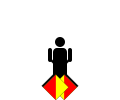 Rest position |
 Numerals |
 Attention |
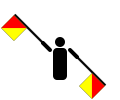 Cancel | ||
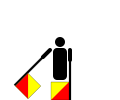 A / 1 |
 B / 2 |
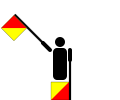 C / 3 / Ack |
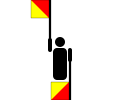 D / 4 |
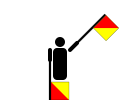 E / 5 / Error 9x's |
 F / 6 |
 G / 7 |
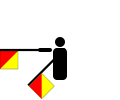 H / 8 |
 I / 9 |
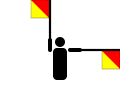 J / Letters |
 K / 0 | |
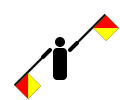 L |
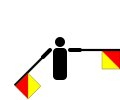 M |
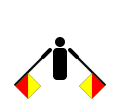 N |
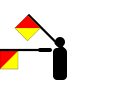 O |
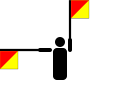 P | |
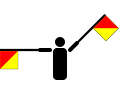 Q |
 R |
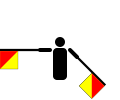 S |
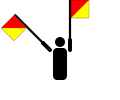 T |
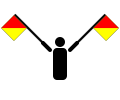 U | |
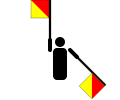 V |
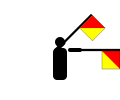 W |
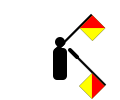 X |
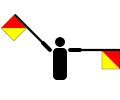 Y |
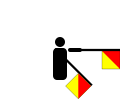 Z |

